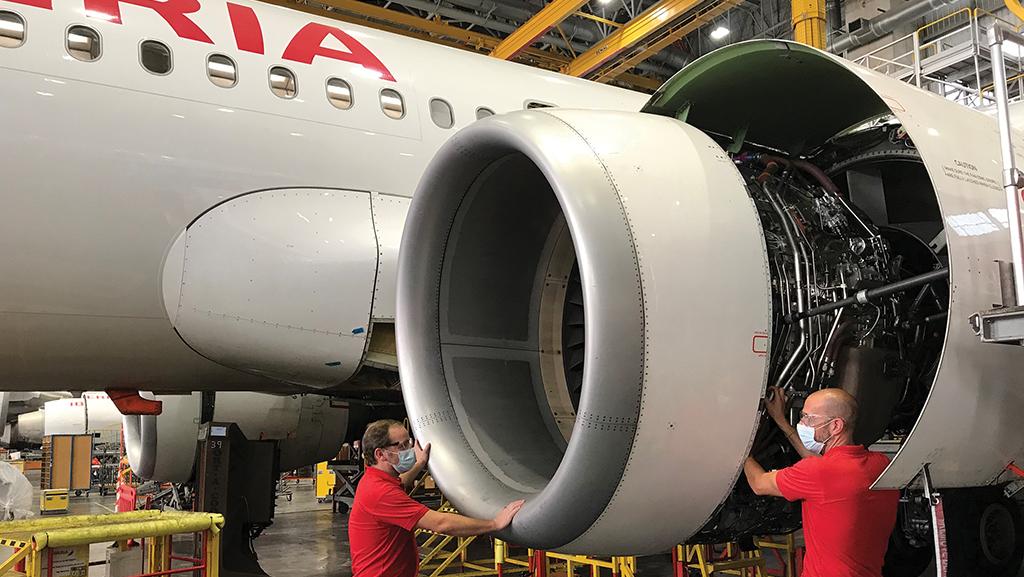Parts Landscape Sees More Leasing | リースの活用が進むパーツ業界

事業の安定成長を維持する際も、不況でダメージを負ったビジネスを再構築する際も、航空会社やアフターマーケット事業者が常に意識する共通点がある。それは「独自性」だ。
「そこには法則性や共通点が見られる。それでも、二つとして同じ航空会社やMROは存在しない」と語るのは、AvAir社CEOのMike Bianco氏だ。
それぞれの企業が持つ客層の違いがチャンスを生み出す。昨今の不況で分かったことは、多くの顧客がバランスシートをスリム化する方法を模索しているということだ。AvAir社のように財務基盤が盤石なサプライヤーにとっては、パーツのリースはますます魅力的な選択肢となっている。
リースは航空業界にとって目新しいものではない。リース会社の成長もあり、機体やエンジンについてはまもなくリースの方が多数派になるだろう。パーツの世界においても、降着装置や補助電源ユニット(APU)といった大型コンポーネントを中心に、リースが果たしている役割は大きい。そしてこの傾向は、顧客がバランスシートのスリム化と現金の確保を求めていることで、さらに拡大している。
魅力的な取引に対応できる資金を確保するために、プライベート・エクイティの支援を受けて2019年にマネジメント・バイアウトを完了したAvAir社は、まさにその恩恵を受けている企業のひとつだ。
Bianco氏は「特にコンポーネントの分野で大きな変化が見られる。エンジン内部というよりも、ライン整備で交換可能なユニットや、ファンブレードやエンジン関連以外の外装部品などが中心だ」と話す。
その理由は単純で、「降着装置やAPUをリースするのは、これらは大型でバランスシートへの負担が大きいからだ。そしてそれは、アビオニクス全般の在庫も同様だ」と彼は説明する。
同氏は、この変化の要因を複数挙げている。その中でも最大のものは、貴重な資金を温存するための中古部品の活用だ。一部の航空会社は保有在庫をローンの担保として設定しているが、これでは問題をバランスシートの他の項目に移動させるだけになってしまう。
「銀行の助けを借りても、真の流動性を得ることはできない。銀行は部品を購入してくれるわけではないからだ。大規模な事業のための運転資金を確保する手段として、他社の在庫に投資するのはAvAirのような会社だけだ」とBianco氏は語る。
もうひとつの要因は「Power-by-the-hour」のような長期包括契約からの移行だ。突発的な需要低下による飛行時間の急減が生じると、サプライヤーはキャッシュフローの問題に直面し、オペレーターは使用していない部品に対しても規定された最低料金を支払うことになる。コロナ危機においては、この双方が代替手段を模索した。サプライヤーは不要な部品の現金化を求め、オペレーターは保有在庫に関連した財務リスクを低減しようとした。
しかし、部品メーカーは今後も顧客ニーズに合わせて商品をカスタマイズし、なるべく多くの長期契約を結ぼうとするだろう。そのため、この変化の原動力はエンドユーザー側にあるとBianco氏は考えている。
「部品の所有を避けたければ、Power-by-the-hourは当然の選択だったが、これは徐々に少なくなっていくだろう。とはいえ、一部の会社にとっては間違いなく有効な手段であることから、これからも残るはずだ。しかし、よりリスクが少ない代替手段を模索しているオペレーターは膨大な数に上る」と同氏は語った。
MRO Prospectorで契約情報を検索し、受注機会を発見しましょう
MRO Prospectorは民間機MRO(メンテナンス・修理・オーバーホール)契約の特定、予想される個別MRO案件の確認、将来の航空機およびエンジンのフリート規模を把握するのに役立つオンラインツールです。この製品は、航空会社やMRO事業者とのビジネスチャンスを追求するために、MROマーケットにどのような機会があるのかを知りたい方に向けて作られています。
Whether managing steady annual-growth rates or working to rebuild businesses decimated by a demand downturn, airlines and aftermarket providers always share one common trait—uniqueness.
“There are some patterns and similarities,” says AvAir CEO Mike Bianco. “But no two operators [and] no two MRO providers are the same.”
Such variation within a service provider’s customer base fosters opportunity. One ramification from the recent downturn is customers looking at more ways to lighten their balance sheets. For well-capitalized parts suppliers such as AvAir, parts leasing is increasingly another intriguing option.
Leasing is hardly new to aviation. Growth among lessors means aircraft and engines will soon be more likely to be leased than not. Leasing has played a role in the parts world as well, typically with larger components such as landing gear and auxiliary power units (APU). But the trend is spreading, as customers seek ways to both take pressure off balance sheets and inject cash.
AvAir, which completed a private equity-backed management buyout in 2019 in part to have funds available to spend on attractive deals, is among those reaping the benefits.
“We’re seeing it pretty heavily on the component side,” Bianco says. “Not quite into the engine internal [areas], but line-replaceable units and some other external parts like fan blades and other [non-engine] components.”
The reasons are straightforward, he says. “You lease landing gear and APUs because they are big and expensive and cumbersome on a balance sheet. Well, so is an entire inventory of avionics.”
Bianco sees several factors driving the shift. The largest is a desire to use surplus assets to generate much-needed cash. While some carriers have used their inventories as loan collateral, that only shifts the problem to a different part of the balance sheet.
“You can’t get true liquidity with the help of a bank,” Bianco says. “A bank is not going to buy material from you. The only people who are going to invest in that type of inventory to free up working capital for some of these larger operations is a company like AvAir.”
Another factor that could have staying power is a shift away from power-by-the-hour and similar long-term agreements. A sudden dip in flying hours that comes with a demand slump can leave suppliers with cash-flow issues and operators paying a stipulated minimum fee for parts they are not using. During the most recent crisis, both sides began to seek alternatives. Suppliers sought to offload unneeded parts in exchange for cash, while operators wanted less financial risk tied to their inventory.
Although parts suppliers will still tailor their offerings to customer needs and set up as many long-term agreements as they can sell, Bianco sees end-users driving change.
“Power-by-the-hour was the mainstay if you didn’t want to own the parts,” Bianco says. “I think that it’s going to be less common. People will still do it, for sure. There’s no doubt in my mind it works for certain folks. But there’s a pretty deep list of operators who are looking for alternatives that are less risky.”
